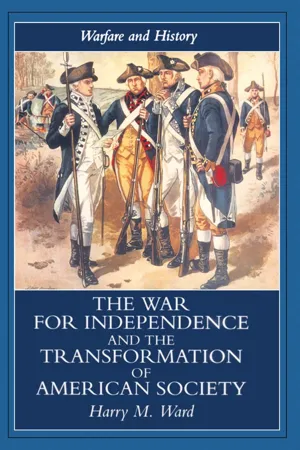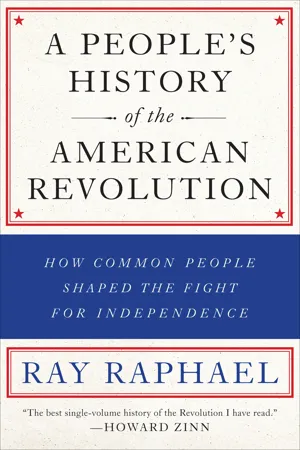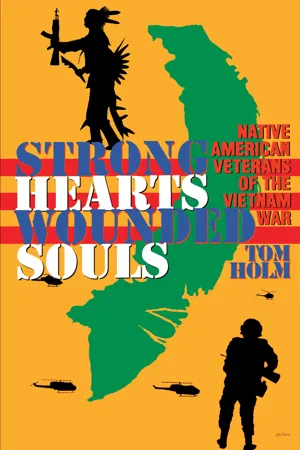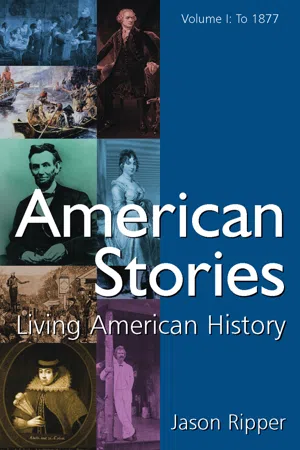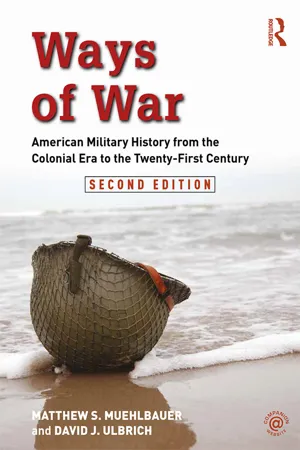History
Native Americans in the Revolutionary War
Native Americans played a significant role in the Revolutionary War, with many tribes choosing to support either the British or American forces based on their own strategic interests. The Oneida and Tuscarora tribes allied with the Americans, while the Mohawk and Cherokee sided with the British. Their involvement in the war had lasting impacts on Native American communities and their relationships with the newly formed United States.
Written by Perlego with AI-assistance
Related key terms
6 Key excerpts on "Native Americans in the Revolutionary War"
- eBook - ePub
The War for Independence and the Transformation of American Society
War and Society in the United States, 1775-83
- Harry M. Ward(Author)
- 2014(Publication Date)
- Routledge(Publisher)
CHAPTER THIRTEEN Native AmericansNative Americans, on the eve of the Revolution, were caught between two social forces: pan-Indianism and inter-tribal and intra-tribal division. Very little supra-authority affected the daily lives of the Indians, whose primary attachments were to kin, clan, and village. Bands found their turf and remained relatively isolated from other groups. From time to time a spiritual revitalization movement occurred, bringing Indians of a region together, as was evidenced, for example, among the Ohio country tribes in the Pontiac Uprising of 1763 and again during the War of 1812 period. The southern tribes, in their social organization, were much like their counterparts in the North. They, too, were beginning to experience the thrust westward of land-grabbing pioneers and speculators, despite living largely in the transmontane region. The Cherokees had fought a bloody war (1759–61) defending their eastern home territory.From 1763 to 1775 the Indian country was at peace in relation to the British imperial and colonial governments. The Indians had all but been cleared out of the Atlantic coastal plain, affording a little breathing space before the rising intensity of white settlers crossing the mountains and beyond.Indian populations in the area now making up the United States from the Mississippi to the Atlantic Ocean were not large. At the start of the Revolution the total Iroquois population amounted to about 11,000; the aggregate of the Ohio country and eastern Great Lakes tribes (other than the Iroquois), 18,000; Cherokees, 12,000; Creeks, 18,000; Choctaws, 8,000; and Chickasaws, 1,400).1The coming of the Revolution drew Indians into military alliances with the British or Americans. Some tribes, attempting neutrality, delayed commitment until well into the war, and tribal factions had divided loyalties. But overwhelmingly the American Indians, whether directly allied or conducting war on their own, came down on the side of the British. Various factors affected this decision. Most Indians were tied to white trade networks under the auspices of the crown, and the British had the capabilities of supplying gifts and trade goods to a larger extent than could the Continental Congress or the new state governments. The British government had tried to restrain westward white advance, while the colony-state governments did not. To most Indians the British seemed the likely winners of the war. Moreover, frontier atrocities inflicted by whites on Indians necessitated revenge. - eBook - ePub
A People's History of the American Revolution
How Common People Shaped the Fight for Independence
- Ray Raphael(Author)
- 2011(Publication Date)
- The New Press(Publisher)
The Seminoles fared better than others because they lived in a colony which did not come under the jurisdiction of the land-hungry United States. This leaves us to wonder how other native peoples might have fared if the Revolutionary War had not been waged, or if the outcome had been different. If the new and expansionist United States had not prevailed, would Native Americans between the Appalachias and the Mississippi have been able to hold onto their lands? The Native Americans probably would not have kept their homes forever, but they might have held on longer than they did if not for the American Revolution. It took the English colonists a century and a half to dominate the countryside from the Atlantic to the Appalachias. In the wake of the Revolutionary War, it took white settlers scarcely a decade to conquer another equally large region.The American Revolution, a fight for freedom from colonial rule, was also the most extensive and destructive “Indian war” in the nation’s history. Whereas other wars affected individual nations, the Revolution affected all Native Americans east of the Mississippi. The effects were felt on many levels:• It killed people—primarily warriors, but others as well. It burned their houses and destroyed their food, making them cold and hungry. It took away their land, hindering their ability to produce more food for the future. It—the war itself, whether its agents were white or Indian, Whig or Tory—made Native Americans suffer.• It provoked serious dissension by exaggerating the differences between factions that normally occur within leadership groups, between generations, and among the various nations.• It militarized Euro-Americans, the very people who would eventually dispossess the Native Americans from their homes. In the words of David Ramsay, it “diffused military ideas” among the rebellious colonists and “gave them experience in the business of war.” Once the patriots had defeated the mightiest empire on earth, they assumed they could subdue Native peoples.• - eBook - ePub
Strong Hearts, Wounded Souls
Native American Veterans of the Vietnam War
- Tom Holm(Author)
- 2010(Publication Date)
- University of Texas Press(Publisher)
It must be remembered that the United States, despite an extremely violent history, really does not have strong military traditions. The American Revolution was fought with an army made up of ill-disciplined, poorly equipped irregulars, who were probably more adept behind a plow than a musket. Although George Washington was no doubt an inspiring leader, his skills as a general officer were questionable. He had, after all, been beaten by Native American and French forces in his 1753 expedition against Fort Duquesne and was a Virginia militia officer in Braddock’s ill-fated command. A large number of commanders on the American side during the revolution—von Steuben, Kościuszko, Pulaski, Lafayette—were not only foreign-born but also had learned their military skills in Europe. The newly declared independent colonies sunk deeper in debt and were wary of maintaining a standing national military force. In many ways, the new nation dealt with other nations—both Native American and non-Indian—from a position of military weakness.Although the Continental Congress had, in 1775, assumed direct responsibility for Indian affairs and continued throughout the Revolution to court Indian allies to join the colonial war effort, most of the tribes sided with the British. It was not until three years into the war that Congress finally signed a mutual aid, peace, and friendship treaty with the Delawares.45 Eventually Washington was “empowered to employ a body of 400 Indians,” and thought that they would be of “excellent use as scout and light troops mixed with our own parties.”46 This was the first of several Native American contingents to serve as allied nations in the American cause.Following the war with the British for independence, the Americans found themselves in an extremely difficult position. On the one hand, they had grave financial burdens as a result of the debts incurred paying for the war and were still not wholly convinced they needed a standing army. Thus, the United States in the early national period was both ideologically and economically unable to maintain a large enough military force to protect itself from outside aggression and, at the same time, police the frontier, for, incredibly, given the nation’s limited resources, the new government had made territorial expansion state policy. Indian tribes, into whose lands the Americans came in droves, could hardly be expected to bow humbly to United States aggression. Wars broke out between tribes and confederated Indian groups and the United States with increasing frequency. Since it was obvious that the Americans could not simply beat the tribes into submission by force of arms, the government continued seeking tribal allies and played on intertribal enmities to carry out expansion.47 - eBook - ePub
American Stories
Living American History: v. 1: To 1877
- Jason Ripper(Author)
- 2015(Publication Date)
- Routledge(Publisher)
These Indian peoples and their descendants would wait until 1924 to be granted citizenship in the United States. There were exceptions, like Mary Jemison, who was given citizenship by New York State in 1817, but she was already an exception, a white Indian, and she lived out her days passing back and forth between Seneca and white communities. In 1783, more than 2 million white Americans gained a new kind of freedom—relative self-determination. White Americans then used that freedom to dominate the rest of the continent in the ensuing decades. The American Revolution reshaped the world. It was also a War of Independence for the Iroquois Confederacy, the Delawares of Pennsylvania, the Cherokees and Catawbas of the South, but they did not win, even though, in the words of Colin Calloway, “Indians remained a force to be reckoned with at the war’s end.” 7 Joseph Plumb Martin: A Common Soldier in the Continental Army Joseph Plumb Martin enlisted in the Continental Army in 1776. He endured gnawing hunger and the near-constant searching for his next meal throughout the war. Martin did fight, but his day-to-day experiences boiled down to missed meals, the scabrous misery of smallpox, and a sense for the way that Washington’s army moved through communities that were not thrilled to have thousands of ravenous men feeding off their fields and livestock. Patrick Henry and Thomas Jefferson of Virginia, Samuel Adams of Massachusetts, and Benjamin Franklin of Pennsylvania were influential men who risked their lives for the cause of independence, but none of them actually fought in the Revolution. They all could have been hanged as traitors, but none of them hefted a smoothbore musket that had to be precisely loaded in the midst of a battle, using an oxen powder horn to tip in the powder. The armies of the United States were made up predominantly of the poor, who enlisted at first out of patriotism, but as the years went on, for promises of signing bonuses and land grants - eBook - ePub
Ways of War
American Military History from the Colonial Era to the Twenty-First Century
- Matthew S. Muehlbauer, David J. Ulbrich(Authors)
- 2017(Publication Date)
- Routledge(Publisher)
The American Revolution, 1763–1783In early 1763, many people regarded Great Britain as the most powerful country in the world. It had mustered astonishingly large military forces in the Seven Years War and deployed them around the world in successful campaigns, including the conquest of Canada. With the ratification of the Peace of Paris, Great Britain ruled all of North America east of the Mississippi River. But afterward, the British government struggled to cope with the enormous debt created during the war and faced challenges in the American backcountry. Native peoples had had no say in the deliberations that ended the French and Indian War, and their territories and traditional lifestyles faced growing pressure from settlers migrating westward. These tensions erupted in Pontiac’s Rebellion of 1763, which demonstrated to officials in London the need for security in the colonies. But they imposed their policies in a heavy-handed manner that contravened the traditional light touch applied to British America prior to the Seven Years War. The result was an imperial crisis that ultimately produced a new, independent country.In this chapter, students will learn about:- Factors that led to conflict between Great Britain and its North American colonies.
- British and American strategy in the War of the American Revolution.
- The major campaigns, battles, and commanders.
- How diplomatic, political, and logistical factors affected military operations and were in turn impacted by the outcomes of battles and campaigns.
- The different types of combatants and how they fought.
Native Peoples and Pontiac’s War
British officials and settlers’ relations with native peoples were often strained during the French and Indian War. One case involved the Cherokee, longtime allies of South Carolina. In 1758, colonists attacked warriors returning from Pennsylvania, while Carolina settlers poached game in Cherokee hunting grounds. In 1759, warriors retaliated by killing some frontiersmen. The South Carolina governor stopped all trade with the Cherokee and took chiefs hostage who had journeyed to Charleston to negotiate. In 1760 Cherokees raided backwoods settlements and forts. A British expedition to attack Cherokee towns that summer faced fierce resistance in the mountainous terrain and withdrew, but a larger, better organized campaign devastated Cherokee towns in 1761. Facing disease, starvation, and raids from other native peoples, the Cherokee sued for peace. - eBook - ePub
Indigenous Peoples and Globalization
Resistance and Revitalization
- Thomas D. Hall, James V. Fenelon(Authors)
- 2015(Publication Date)
- Routledge(Publisher)
HAPTER 5 American Indian Survival and RevitalizationNative Nations in the United StatesI N THIS CHAPTER we discuss indigenous people’s struggles in what has become the United States and Canada. We discuss the Wampanoag and then focus on the Lakota peoples, who together experienced one of the earliest and one of the last conquests by peoples of European ancestry in the history of the United States. We also discuss the Navajo (Diné) and more briefly several California peoples, both to add breadth to our discussion and to present the considerably different experiences of peoples first conquered and absorbed by Spain. This is a very small sample of the well over 500 different “nations” who inhabited the territories that eventually became the United States. Yet, we argue their collective experiences bracket the range of experiences of indigenous peoples with Europeans in the United States. These discussions add to the basis for comparing and contrasting with experiences elsewhere in the world and support our argument for why these processes and experiences require a global, as well as a local, understanding.For each of these examples, we consider four important analytical perspectives—historicity, resistance modalities of survival, social justice issues, and revitalization. For many people, American Indian peoples have become archetypes of indigenous struggles against colonialization, of limited survival, and of resistance. Some say this has risen to the level of stereotypes. Over the past fifty years or so, American Indians have become emblematic of movements to reestablish their legitimate status as sovereign nations although most of the rest of the world is in sharp conflict over the status of sovereignty, and relations in the United States are as much internal colonies as independent nations. Nonetheless, the devolution of independent native nations under colonialism and later U.S. expansion and incorporation, at times rising to the level of genocidal war, contrasts with a rising rule of law in the twentieth century affirming American Indian nations and leading to a firm sovereignty as “domestic, dependent” status in the United States and as “First Nations” in Canada. This compelling story varies widely by the temporal period of incorporation and the geographic location of the indigenous peoples, making each nation unique even as there are shared aspects. Therefore, we ground our discussion with descriptions of individual Indian nations, beginning with the Wampanoag peoples.
Index pages curate the most relevant extracts from our library of academic textbooks. They’ve been created using an in-house natural language model (NLM), each adding context and meaning to key research topics.
